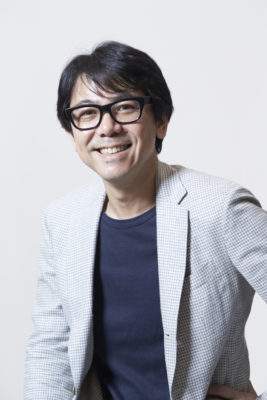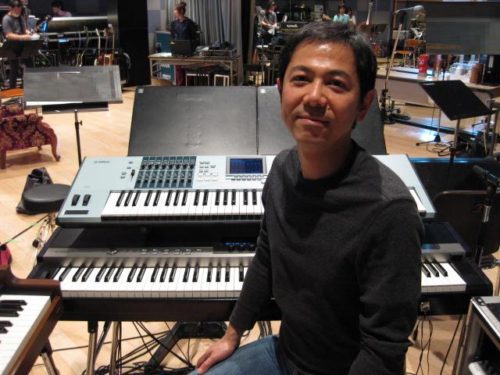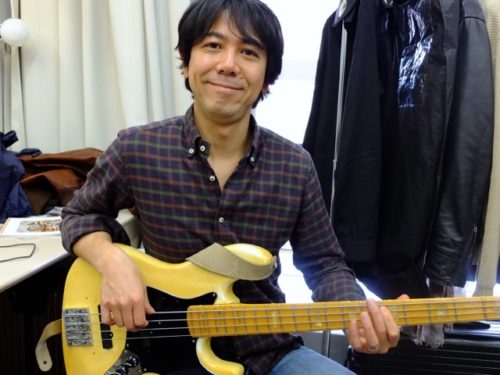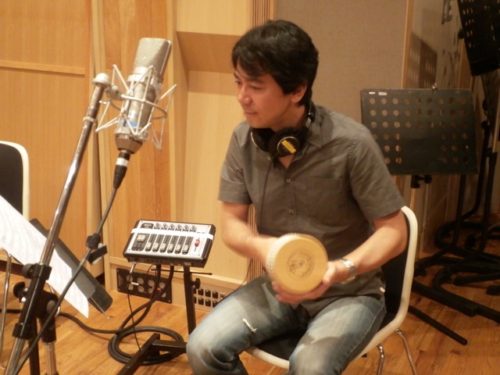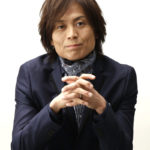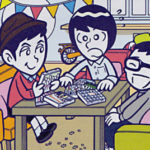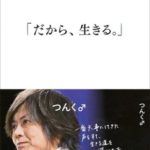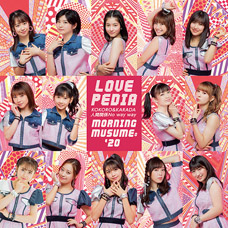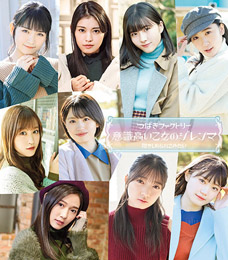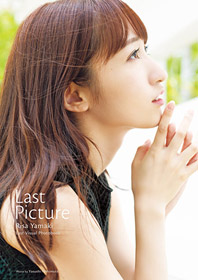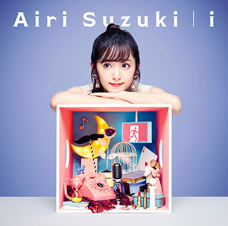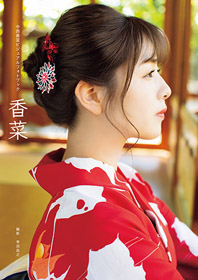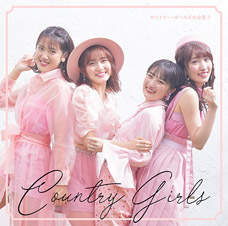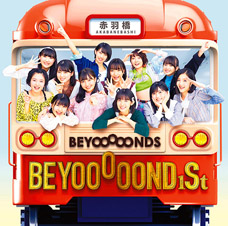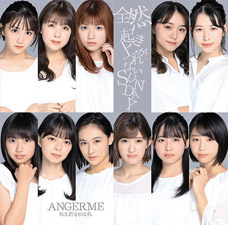Beginning with his keyboard contributions on “Ai no Tane,” Kono Shin has since gone on to leave behind a number of notable works, including Morning Musume’s “Manatsu no Kousen” and “I WISH,” Melon Kinenbi’s “Kokuhaku Kinenbi,” and ZYX’s “Iku ZYX! FLY HIGH.” Having worked on a great number of arrangements, he describes his work with Hello! Project in particular as having been “considerably free.” How exactly did these Kono works come to be?
— The first work you did in relation to Hello! Project was playing the keyboards on “Ai no Tane.” How did that happen?
Kono: I was playing in a band called SPANK HAPPY at the time. (Note: the band’s lineup consisted of Hara Midori, Kikuchi Naruyoshi and Kono Shin. They have since disbanded.) Our company at the time was working with this band called COSA NOSTRA (a band led by Sakurai Tetsutarou). Through that connection, I would often play keyboards on Sakurai’s works, so when he was called in to compose and arrange Morning Musume’s “Ai no Tane,” he asked me to play keyboards on it. The musicians who played on “Ai no Tane” were mostly all close acquaintances of his. Another thing is, I had already been a supporting member for Moritaka Chisato so I wasn’t even that far removed from Up-Front. That was a big reason as to why I later became an arranger for Hello! Project.
— Were you aware of Morning Musume when you became involved with them?
Kono: The ASAYAN TV show was hugely popular at the time and I suppose I kind of knew they’d been formed through auditions on that show. I’d also heard about a group that had to sell a certain amount of copies of their CD in order to debut, so I was like “ah, okay, so that’s the song I’m going to be playing on.” (laughs) I also thought Sakurai had written a good song for the occasion. I knew him as someone who could write these great songs with a 60’s/70’s style, pop/soft-rock taste, and I felt like that song was a good example of that. Later, when I played keyboards on “Morning Coffee,” I thought “alright, I think he finally achieved his goal.“
— But wasn’t it from that song onwards that Tsunku♂ became the songwriter and producer?
Kono: Yes, but Sakurai was the arranger, and I felt like it was from that point on that Up-Front themselves decided they wanted to take the group in that “band-style” direction as far as their music went.
— You yourself first became involved in the production side of things when you arranged Tanpopo’s “Motto.”
Kono: Me and Maejima Yasuaki — arranger of “Memory Seishun no Hikari” — actually went to New York to record the instrumentals for these songs. We got these well-known musicians by the names of Will Lee and Hiram Bullock to play bass and guitar, respectively. We sort of figured out how to go about producing Hello! Project songs through that experience, and that’s why they later invited me back to arrange “Manatsu no Kousen.”
— What are the orders for arrangements like when you get them?
Kono: I get a programmed demo tape from Tsunku♂ and I decide how I want to approach it. In other words, in my case, I personally never got orders asking me to take the arrangement in any predetermined direction.
— “Manatsu no Kousen” was the first Morning Musume single to include hints of disco and soul — was this your idea, too?
Kono: Yes. I threw in live instruments and some harpsichord to give it that sparkle, because I remember thinking “hmm, what sorts of sounds would be representative of manatsu (“midsummer”) and kousen (“rays of light”)…?” No, wait. I forget: was it only after the song was done that the title was chosen? (laughs) Well, in any case, I remember hearing the demo and thinking to myself that the song deserved a sparkly arrangement like that, so that’s how I proceeded.
— How much were you present during the recordings?
Kono: Naturally I was there for the recording of the entire instrumental. I’d come into the studio with a synth with the basic track prepared and the instrumentalists would record their parts one-by-one. Tsunku♂ would be in charge of the singing bits and other vocals, and then we would together try to find the perfect balance in mixing… That’s pretty much how it worked.
— “Manatsu no Kousen” has those very prominent “fuwa fuwas!” in there…
Kono: That was Tsunku♂’s idea. But a lot of the time it was case-by-case with those backing vocals and all the other miscellaneous vocals. For example, with a song like Matsuura Aya’s “Motokare” (off her album T・W・O), I went ahead and personally called up backing vocalists to sing on it when I was only just making the arrangement. (laughs)
— It feels like many of the arrangements you do for Hello! Project are heavily influenced by black music — namely soul and disco. How did that come to be the case?
Kono: I think the biggest reason is that I’m a keyboard player at heart. My arrangements might be more rock-oriented if I approached them from a guitarist’s standpoint, but since I have to think about how to make exciting keyboard-centric music, it often leads to the songs having a disco or a Philly soul sound. Plus, the orders I get tend to be for songs they want to use to fire up the audience. I personally like that whole sound with the many secondary melodies, so it just worked out that way naturally.
— Those vibrant soul arrangements of yours always left a big impression on me.
Kono: Well, Hello! Project employs so many different kinds of arrangers, and I think Tsunku♂, too, sees the value in giving those arrangers independence in their work — you get more variety that way.
— Ah, but see, having talked to many of those other arrangers, they’ve told me that in many cases Tsunku♂ will give them reference songs as to how he wants the arrangement to turn out. It might be that you’re one of the rare exceptions in that they just leave it completely up to you.
Kono: Oh, is that right? Maybe they just couldn’t bring themselves to do that with me since I’m older. (laughs) Well, perhaps it’s not that common for them to leave it up to the arranger then. You know, it could just be that if Tsunku♂’s demo is funk, he knows what he’s going to get if he hands it over to me — more funk. Maybe that’s it.
— What are Tsunku♂’s demos like, by the way?
Kono: It’s just the vocal melody and him accompanying himself on the synthesizer.
— That sounds very basic!
Kono: Yes. I have to find the melody line in it, and I have to figure out the most fitting chords and how to make the song the way I most like it. Doing it that way is great fun. It’s both very challenging and very fun, in equal amounts. I have only the demo, and I have to listen to it and think about the direction in which I’m going to take it, how to build it into a proper J-pop song, and how to make it something that captures the listener’s ear.
— So it almost feels like play to you?
Kono: Right. Tsunku♂ purposefully leaves room in the song for the arranger to have fun with.
— When I first heard that bass line in “Manatsu no Kousen,” I remember thinking to myself if it was even legal to have a J-pop song where the bass moves all over the place that much. It really caught me off-guard.
Kono: The bass line hectically moving all over the place, going up and down, down and up — that’s what makes a song exciting, isn’t it? That’s what I was trying to do. And when I do want a bass line like that, I ask Irie Naoyuki to play it for me. He’s the kind of guy who can play bass like that. And when recording that song, I asked him to make it “move around even more!” (laughs) I asked him to go crazy and just run with it, and that’s how the song turned out. On an unrelated note… Morning Musume at the time were very busy so we were all working on a very tight schedule. While we were working in one studio recording the instrumental, Morning Musume would be in a separate studio on the same floor recording their vocals. We were working on both parts pretty much concurrently! We didn’t even have Pro Tools at the time, so as soon as we’d finished the instrumental, someone would have to run with the tape to the other studio for them to record the vocals. It was pretty crazy.
— Coconuts Musume’s “Tokonatsu Musume” is very reminiscent of the Jackson 5’s “I Want You Back“…
Kono: We tried lots of things with that song, too, until we came to the conclusion that the Motown approach might work for it the best. Yeah, we pretty much used “I Want You Back” as the blueprint for that song — sort of like how we used Earth, Wind & Fire as the blueprint for Kiiro 5’s “Kiiroi Osora de BOOM BOOM BOOM.” I think those may be the only two songs where we were that blatant.
— I think it might be because of songs like that which help explain how fans at the time were so into searching for the songs that inspired Hello! Project originals. Like the theory about Melon Kinenbi’s “Kokuhaku Kinenbi” having been inspired by Van McCoy and such, or to give you another good example, Coconuts Musume’s “DANCE & CHANCE” and it’s grandiose disco house sound, what with the members’ inability with Japanese at the time… fans loved how obvious the inspiration was. Did you think about the groups’ individual characteristics as you were working on their songs?
Kono: I just felt those approaches might work for the songs, even if it was girl groups that were going to be singing them. Honestly, while the groups’ characteristics did play a small part in the process, it was never the main thing. While I do think about their previous songs and their voices and things like that, it’s not really a top priority for me when I’m arranging the song. But with groups like Coconuts Musume and Taiyou to Ciscomoon, I did at times think about how a change in direction might be good — that kind of thing. Like, Taiyou to Ciscomoon were the older group, so I thought about how I ought to make their arrangements more direct. Little things like that.
— True: Taiyou to Ciscomoon’s arrangements did have a “fuller” sound.
Kono: We just happened to go for that kind of balance during the mixing process. I think it was pretty much unconscious on our part.
— What is a Tsunku♂ song that was especially memorable for you to work on?
Kono: Hmm… While it wasn’t actually a Hello! Project song, I’m going to say EE JUMP’s “LOVE IS ENERGY!” I actually first declined to arrange this song just because I was so busy. But then they asked me if I was free at midnight one night… I said I was, and they told me they’d reserve the studio for me at that time so I should just head over and work from there — at midnight. (laughs) Usually, I’d get started on the programming at home, but this time we were working on such a tight schedule we didn’t have time even for that. Also, even though that song was entirely programmed, there are slight changes in tempo. The reason for that is Tsunku♂ suddenly asking me, “hey Kono, can we change the tempo on this bit and this bit?” I just thought to myself, “wow, this man is very… open-minded.“
— By the time you were to arrange Morning Musume’s “I WISH,” they were already well on their way to stardom after “LOVE Machine,” “Koi no Dance Site,” “Happy Summer Wedding” — all the huge hits DANCE☆MAN had arranged for them…
Kono: It didn’t really change how I personally felt about working on their music, but it did change things on the production side of it. (laughs) See, that song was to be the theme song for the Sydney Olympics, and I remember thinking “hmm, Olympics… alright, we’ve gotta have some horns.” And that’s the reason the song has them.
— That’s the whole reason for that horn section before the chorus?! (laughs)
Kono: I swear, that’s all it was. (laughs) And then Tsunku♂ put in those voice percussion bits near the beginning…
— Ah, that part in the opening before the vocals, with the organ, beatboxing and those breakbeat-like drums…
Kono: Yeah. Tsunku♂ put those in after I’d played my organ parts on the song. Tsunku♂ would quite often add things he felt the song needed once I’d finished my arrangement.
— When you’re working on an arrangement, is there something you always do the same way if it’s going to be a Hello! Project song?
Kono: Not particularly, no. As the arranger, I think about putting something in the arrangement that hooks the listener. If the melody and chords are relatively simple, I make up for it by giving the rhythm something special. Or I do something interesting with the chords. Just, a little something somewhere in the song to hook the listener. That’s one thing I always try to be conscious of.
— Something that makes you feel.
Kono: Right. Something that makes you feel something. Or something that’s a bit quirky. Something that adds a little something to the song. Even if the melody already has that “something” in it, if my arrangement can contribute something even more to the song, that’s going to make for an even more special song.
— Do you try to keep up-to-date with what the other Hello! Project arrangers are doing in their work?
Kono: For the most part, no — it’s not like it’s a competition. I haven’t even met many of them. Besides, I haven’t actually worked on that many Hello! Project songs to begin with.
— I’m surprised to hear that!
Kono: I’ve worked on many more B-sides and album songs than singles. Maybe the singles I arranged for them didn’t sell very well? (laughs)
— “Popcorn Love!,” the B-side of “Mr. Moonlight ~Ai no Big Band~,” left a huge impression on me.
Kono: Ah, I’m glad to hear that. I think I remember giving them advice on the chorus vocals on that song.
— Who among the members do you remember specifically for their singing, or for their expressiveness?
Kono: Matsuura Aya. Now there’s a singer who can express such a variety of things in just one song. I really liked her as a singer. “I know” (B-side of “The Bigaku“) and “Egao ni Namida ~THANK YOU! DEAR MY FRIENDS~” (off her album First KISS) are some of my personal favorites of my own work.
— While the songs you worked on for Morning Musume were rooted in black music, the five songs you did for Matsuura were very varied.
Kono: Yeah. I think “Motokare” might be quite different from all the rest of my work for Hello! Project. The original order for that song was to make it ballad-like, but I didn’t want to make it too much so and I went ahead and made the rhythm more pronounced. I loved Matsuura’s singing on this song. She had a great grasp of how to convey even the minor nuances of the song and she sung it with so much feeling. I actually think “Motokare” might be my favorite Matsuura song.
— The arrangement really lets the composition and singing shine. It’s kind of like Timbaland’s R&B arrangements, in that it leaves space in the sound of the beat and the track — it’s the kind of sound which really tests the abilities of the singer.
Kono: She really did a great job of conveying that sadness of a young girl.
— Then on the opposite end, she sang “I know” in such a cheerful way.
Kono: Right. That variety is great.
— Matsuura’s “I know” was released in September 2002, whereas Goto Maki’s “Kimagure” (B-side of “Yaruki! IT’S EASY“) — also arranged by you — was released only a month prior to that. While “I know” was like the “yang” of Matsuura, “Kimagure” was like the “yin” of Goto. It was like a comparison of the two aces of the day. I remember how the idea felt so thrilling at the time, especially after learning it was you who had arranged both songs.
Kono: Ah, right. I actually didn’t remember that. (laughs) I only just now learned that “Kimagure” and “I know” were released around the same time. Also, there’s a time delay between when I arrange the song to when it’s released. With more recent songs I’ve worked on, such as Morning Musume’s “Love Innovation” (B-side of “Wakuteka Take a chance“) or °C-ute’s “Attakai Ude de Tsutsunde” (B-side of “Kanashiki Amefuri/Adam to Eve no Dilemma“), I didn’t know who was going to sing those songs when I got the orders. I only got to know that when the songs were released. Back in the old days I’d know beforehand who was going to get which song; more recently, I don’t.
— As Morning Musume is very invested in the dubstep/EDM style with their recent songs, the straight-up pop of “Love Innovation” felt like a return of sorts for the group. I think they very much benefited from your long-awaited return and arrangement.
Kono: Honestly, I didn’t pay any mind to the direction Morning Musume has been doing lately — I only did a simple arrangement that felt fitting for the simple song that was given to me.
— When you’re working on your arrangements, how much do you pay attention to what’s currently popular in music in general?
Kono: None. Electro music and stuff like that is interesting to me as a listener, but I would personally have no idea about how one would go about creating those kinds of sounds. That’s why all my arrangements tend to have either real live instruments or — if I’m working on a song digitally — simulated live instruments.
— The reason I asked you that is because of “Love Innovation” having that 80’s synth drum sound — I figured you might have been influenced by the recent 80’s revival thing…
Kono: Well, I do hear from people saying they’ve been hearing those kinds of drum sounds a lot on more recent songs. But more than that, it really all comes down to what’s right for the song.
https://www.youtube.com/watch?v=bzK3U9-xkzQ
— Finally, I’d like to ask: what would you say makes Tsunku♂ special as a melody maker?
Kono: When I first listen to his demos, the melody and chords tend to sound clichéd — there’s something about them that just oozes that “sense” of Japanese people from ages back. But the thing is, when the song is finished, it turns into something very enjoyable and fitting. He takes the sound that Japanese people tend to like, but makes it into something that doesn’t sound trite or old-fashioned. I can hear that in the songs I arrange for him, but even more so in the work of other arrangers. And that’s why even if the arrangement of a song goes too far, you always have this peace of mind listening to it. I think he simply has the sense needed to write songs like that.
— So his songs are the perfect fit for Japanese sensibilities?
Kono: Exactly. He never forgets that. You really hear that when you listen to his demos.
— Perhaps that’s what makes your arrangements of his songs so good: they stay just faithful enough to the composition.
Kono: Yes. It could be that me and him have just the right compatibility in that sense.
Interview & text: Takagi “JET” Shinichiro
English translation: Henkka
Kono Shin on the web: website, Twitter

